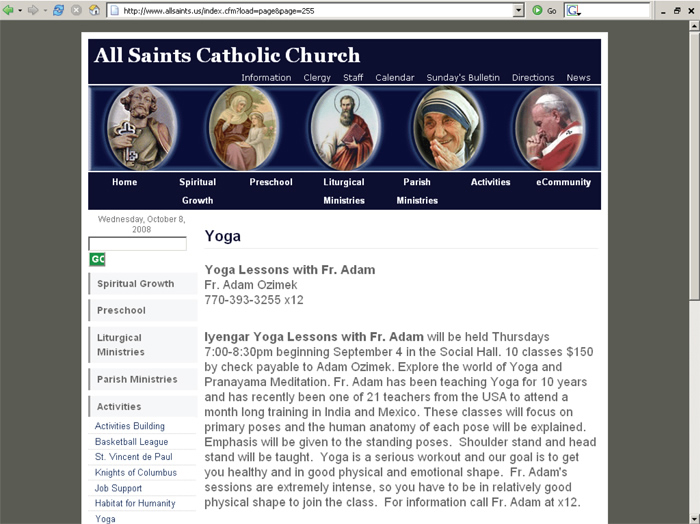Yoga Classes
At Local Catholic Church
There are many different ways to achieve enlightenment within the New Age movement. One method that combines physical exercise, mantras and meditation is called yoga. In this highly acclaimed form of self-discipline, the practitioner seeks to yoke himself to God by practicing the following eight stages of self-purification:
In the first two stages of yoga the practitioner takes moral and ethical steps to prepare himself for God-consciousness. These stages can include fasting, moral living and meditation. In stages three and four, the practitioner performs physical exercises, stretches, and body postures while practicing breathing techniques and chanting mantras.
In the fifth stage the practitioner attempts to withdraw his senses, and in the last three stages, the practitioner becomes more involved with deeper forms of meditation in an attempt to complete the final stage, which is God-consciousness.
There are many different styles of yoga, and each type encourages a different path to liberation and enlightenment. A common form of yoga in India is called Dhakti. Another popular form of yoga is called Hatha, and it places more emphasis on the "energy flow" that participants invite into their bodies. Tantra yoga centers on the worship of the Hindu supreme goddess named Shakti. This deity is worshiped as the divine mother who calls for absolute surrender.
Those who practice and promote yoga claim that the supernatural energies that are released to flow inside of a person's body have remarkable healing and life-changing properties. The benefits of yoga include better balance, a more active sex life, an increased ability to focus, a deeper sense of relaxation, more flexible joints, and overall improved health.
The problem with yoga comes from the meditations and mantras that are used to invite spiritual energy into a person's body. Many of the mantras used in yoga invoke the names of foreign gods and goddesses asking them to send forth different types of spiritual energy. According to one yoga website, when a practitioner chants "Guru Guru Wahe Guru, Guru Ram Das Guru," that person is calling upon a spiritual entity named Guru Ram Das, asking for spiritual guiding light and protective grace.1
When a practitioner chants, "Prana, Apana, Sushumna, Hari, Hari Har, Hari Har, Hari Har, Hari," that person is calling upon three different spiritual entities to draw energy up from the spine for healing. Prana is the god of life force, Apana is the god of eliminating force, and Sushumna is the central channel for that force.2
Another yoga website advises practitioners to bow down to the "thousand-year-old tradition," and say a prayer to a god named Patanjali. When practitioners chant the following mantra, "Abahu Purushakaram Shankacakrasi Dharinam Sahasra Shirasam Svetam Pranamami Patanjalim Om," they are actually praying, "to Patanjali, an incarnation of Adisesa, white in color with 1000 radiant heads, human in form below the shoulders holding a sword, a wheel of fire, and a conch, to him I prostrate.3
Although Catholics are required to respect, nurture and take care of our physical bodies, we are not allowed to chant the names of foreign gods, or to invite demonic healing energies into our bodies.
Scripture Passages to Set the Captives Free
"Do you not know that you are God's temple and that God's Spirit dwells in you? If anyone destroys God's temple, God will destroy that person. For God's temple is holy, and you are that temple." — 1 Corinthians 3:16–17
"What agreement has the temple of God with idols? For we are the temple of the living God; as God said, 'I will live in them and walk among them, and I will be their God, and they shall be my people. Therefore come out from them, and be separate from them, says the Lord, and touch nothing unclean; then I will welcome you, and I will be your Father, and you shall be my sons and daughters, says the Lord Almighty.'" — 2 Corinthians 6:16–18
"Life and physical health are precious gifts entrusted to us by God. We must take reasonable care of them, taking into account the needs of others and the common good." — Catechism of the Catholic Church: 2288

For more information please visit Meditations to Center, Transform & Empower.
Notes
The Scripture quotations contained herein are from the New Revised Standard Version Bible: Catholic Edition copyright © 1993 and 1989 by the Division of Christian Education of the National Council of the Churches of Christ in the U.S.A. Used by permission. All rights reserved.
- Kundalini Yoga Popular Mantras: http://www.kundal iniyog a.org/mantra.html
- Kundalini Yoga Popular Mantras: http://www.kundal iniyog a.org/mantra.html
- Ashtanga Yoga Mantra—for the beginning of Ashtanga Yoga practice: http://ashtangayoga.info/ashtanga-mantra/asht anga-yoga-mantra.html
- All Saints Catholic Church, "Yoga Lessons with Fr. Adam": http://www.allsaints.us/index.cfm?load=page&page=255
|